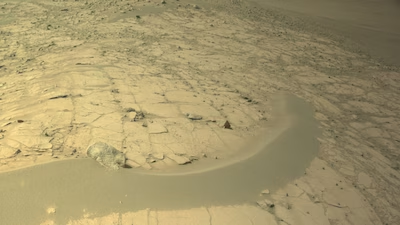Introduction
NASA’s Perseverance rover continues to push the boundaries of planetary science as it explores the ancient Martian terrain beyond the Jezero Crater. As of June 7, 2025, the rover has moved into two significant regions—Fallbreen and the Forlandet quadrangle—where scientists believe some of Mars’ oldest surface rocks may be located.
Fallbreen: A Window into Mars’ Ancient Crust
Perseverance is currently stationed at Fallbreen, a light-toned bedrock outcrop thought to hold clues about the early geological processes that shaped Mars. This site is crucial in helping NASA’s team decode how the Red Planet’s crust formed and evolved over billions of years. The bedrock here is rich in olivine and carbonate, minerals that could indicate ancient water activity and past habitable conditions Perseverance Rover.

Comparing Fallbreen and Copper Cove
Scientists are particularly interested in comparing Fallbreen to a nearby formation called Copper Cove. Both regions show high concentrations of olivine, a magnesium iron silicate that forms in volcanic environments. According to NASA, these studies are vital for understanding the expansive geologic unit that spreads west of Jezero Crater.
These comparisons help map the spread and transformation of Mars’ crust, further revealing whether these rocks formed in volcanic conditions or were altered by water over time Perseverance Rover.
Crossing into the Forlandet Quadrangle
As Perseverance moves on, it has entered the Forlandet quadrangle, a 1.2-square-kilometre sector along the edge of Jezero Crater. Named after Forlandet National Park in Norway’s Svalbard archipelago, this new phase of exploration pays tribute to Arctic explorers of the past, who braved harsh conditions in search of new frontiers—just like Perseverance does today on Mars.
Spirit of Exploration: Svalbard to Mars
Drawing symbolic connections between Earth and Mars, the team behind Perseverance named the region to reflect the legacy of Earth’s explorers. As the rover traverses Martian sand dunes and buttes, it mirrors the endurance and bravery of those who once ventured into the Arctic in pursuit of the Northwest Passage.
Martian Landmarks Named After Earthly Places
Perseverance’s journey through the Forlandet region will involve analysis of various landforms and target rocks, which will be named after geographical locations within and around Norway’s Forlandet National Park. This naming convention not only aids navigation but also celebrates human history, linking the ancient Martian surface to our own planet’s spirit of exploration.
Why This Mission Matters

The data collected from the Fallbreen and Forlandet areas is expected to enhance our understanding of early planetary formation. The mineral composition, layering, and geologic features could offer clues to Mars’ water history and the possibility of ancient microbial life. It also contributes to mission goals for future Mars Sample Return (MSR) efforts.
Conclusion
NASA’s Perseverance continues to deliver remarkable insights from Mars. With its eyes set on the olivine-rich rocks of Fallbreen and the historically inspired Forlandet region, the rover is not only conducting high-level science but also weaving a narrative of exploration that transcends planets. The findings in this leg of the mission may well shape the future of interplanetary research and the search for ancient life.
Learn more about the rover’s tools and discoveries in our guide: Why Jezero Crater Was Chosen for Mars Exploration.









